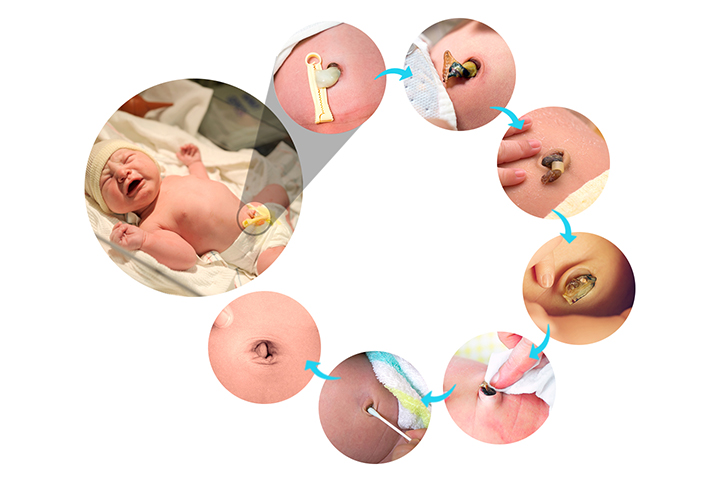How to Donate Your Baby's Umbilical Cord Blood
It's incredible how a woman'south trunk gives the fetus a home, allows it to grow, and guarantees that it receives the diet it needs to thrive through the baby's umbilical cord connected to the mother'southward placenta.
The umbilical string is disconnected at nativity, leaving a stump backside on the baby's abdomen. This stump dries and falls off somewhen, and that is when the baby's belly button or omphalos appears. Even so, until then, you need to accept actress care of the umbilical cord stump to avert any potential infections.
This post explains how to properly care for your baby's umbilical cord stump, including tips on spotting signs of infection and when to seek medical help.
What Is Umbilical String?
The umbilical cord forms during the seventh week of pregnancy. It supplies the developing fetus with oxygen and nutrients, and a means of eliminating waste product. Your infant's umbilical cord is composed of:
- 1 vein that carries oxygen and nutrient rich blood from yous to your growing babe (1).
- Two arteries that ship de-oxygenated blood and fluid matter from your kid'south bloodstream to the placenta.
These three claret vessels are encapsulated in a sticky substance known equally Wharton' jelly, which, in turn, is covered by a membrane called amnion.
Every bit the fourth dimension for the babe'south nascence nears, the umbilical cord carries antibodies from you to your baby, to help the baby ward off infections for the get-go few months after nascence. You pass on the antibodies that are present in your bloodstream.
After the baby's nascence, the cord becomes unnecessary equally the baby can feed, exhale and empty the bowel and bladder without its help. Therefore, it is clamped and cut after delivery.
A pocket-size clench is put a few centimeters away from the navel, and the string is cut off. The remaining stump will be around two to three centimeters.
Tips To Take Intendance Of Umbilical Cord:
The clamped umbilical stump is unsightly, and you might not want to keenly await at it or bear upon it. But you need to take intendance that it is healing normally. It is important to go on your baby's umbilical cord stump and the skin effectually it make clean and dry. This volition make the stump shrivel and fall off, and also prevent infection (2).
- Keep it make clean: If the stump is sticky or muddied, dab it gently with a wet cloth or clean with plain water. Then dry it with a clean cotton fiber cloth to remove whatsoever moisture around information technology. Do not use whatsoever soap or alcohol unless instructed past the healthcare providers, as information technology tin can irritate the skin. Some areas or countries still utilize surgical spirits to make clean the stump. This is dependant on diverse factors, such as the charge per unit of stump infections. Your healthcare provider will assist you with the all-time choice for you and your baby.
- Keep information technology dry out: Betrayal the stump to air then that the base dries out chop-chop. See to it the diaper does not fall over the stump. On warmer days, dress the baby in such a way that the cord area gets enough air.
- Go for sponge bath: Do not dunk the stump under water until it falls off. Sponge baths are ideal at this time. Once the stump shrivels, y'all may bathe your baby in a baby sink or tub.
- Alter diapers advisedly: Some diapers have a little notch in the waist surface area. You may fold down the diaper at the omphalos area and so that it will not fall over the stump. Also, change the dirty and moisture diapers carefully so that they do not leak effectually the navel area.
- Cull loose fitting dresses: Buy tops or onesies that have a special cut near the stump. Use kimono fashion wear equally they permit proper air circulation. Avoid snap-crotch undershirts.
- Permit it fall off on its ain: Do not pull out the stump as information technology volition result in bleeding. Instead, let information technology to fall off on its ain.
When Does The Umbilical Cord Fall Off?
Since the umbilical stump is a living tissue, information technology needs some time to dry out and fall naturally. You may notice some blood oozing out or a small raw spot on the bellybutton region, but that is normal. The healed wound becomes the infant's belly push (3).
The stump, normally, takes five to 15 days to heal, and sometimes a little longer. See a doctor if the umbilical cord does not dry and fall off subsequently four weeks.
This Is How Your Baby'southward Umbilical Stump Heals:
Image: Shutterstock/iStock
Information technology takes about 2 to four weeks for the stump to heal completely. Know how it withers to become the belly button.
Immediately after the babe'southward nativity:
Shortly after the delivery, the string is allowed to remain for some time and so that the nutrients are passed to the newborn. After a few minutes, the doctor or midwife clips and cuts information technology off. The clip is not removed immediately only after a couple of days.
In the first week:
The umbilical stump dries upwardly slowly in the first calendar week and turns into a black or brown cord. It gradually begins to loosen after a week or ten days. When the stump falls off, the region appears every bit an open sore.
The next few weeks:
The open sore takes most two to iv weeks to shut completely, and by and then, your baby would be about ii months sometime. Sometimes, it will also take more than two months to close.
Signs Of Infection:
When the cord is still on, you lot need to ensure that the part is not infected. You should be even more conscientious if your infant was born premature or with low birth weight, or if the string falls off shortly, as these situations can enhance the adventure of infection.
The infection rarely occurs, but if it does, you lot may notice these signs:
- Bloated or red around the string
- Continuous haemorrhage
- Oozing white or yellowish pus
- Foul odor discharge
- Pain in the area
- Fluid-filled lump
- Fever of 100.4°F (38°C) or higher
- Abdominal swelling
- Sluggishness, irritability and low appetite
Yous should immediately check with your child'southward doctor to diagnose the condition as this can exist very unsafe.
When To Telephone call A Physician?
In addition to the above signs of infection, at that place are also certain conditions that require firsthand medical attention:
- Omphalitis: If the navel area is warm, red, tender or swollen or has a foul-smelling discharge, and then it could be omphalitis. This is a life-threatening bacterial infection of the umbilical cord and the surrounding region (4).
- Umbilical hernia: It develops when a function of fat or bowel tissue bulges outward nearly the omphalus surface area. It forms a tiny pigsty in the muscular function when your baby puts pressure on the abdomen while crying. Information technology is not a serious condition and usually heals within the beginning 12 to eighteen months (five).
Umblical cord seldom causes a problem. Keep it clean and dry, and practice not meddle with it. Permit it drop naturally. Until the cord goes and the omphalos forms, there is aught much you can practise expect for gently caring for the expanse.
Frequently Asked Questions
1. What is normal umbilical cord bleeding?
Autonomously from the in a higher place conditions, sometimes the baby'southward omphalos area bleeds after the stump shrivels. It may too bleed before the string falls off, especially, if the stump is accidentally pulled or tugged. Y'all may notice blood spots on your baby's onesie or in the diaper (8).
How to treat?
Clean the area around the belly push button and put slight pressure on the stump to stop the haemorrhage. Make sure the diaper will not rub or press against the stump to avoid bleeding to recur.
When to worry?
If the pressure does not terminate the bleeding, y'all may have to run into a doc, as bleeding can sometimes lead to an infection. Look out for these signs:
- Warm feeling effectually the belly button area.
- Pus-similar or cloudy and smelly belch from the stump.
- Painful for the baby when y'all touch the area.
2. What is umbilical granuloma?
It is a moist, pinkish-red lump of tissue that forms on the omphalos. Y'all can notice it after the umbilical cord shrivels off and may remain for a few weeks. Though it volition not cause any pain, there would be a fluid discharge, which results in redness and irritation in that area.
How to treat?
Your baby'south md might use silverish nitrate to the tissue. Information technology will have around 3 to vi visits to the dr. before the granuloma heals completely. After the treatment, you may notice a dark belch or sometimes staining of the skin, which is temporary (9).
Another treatment uses a surgical thread to tie the lump at the base. The blood supply is stopped to let information technology dry and fall off.. In some cases an ointment might be tried commencement before tie or the silver nitrate. Your doctor will talk over the options with you.
None of these treatments is painful.
3. Can you say whether your baby has an innie or outie?
A baby's omphalus tin can be an innie or outie. There is a misconception that an infected stump results in an outie. Also, some mothers believe that by taping a flat object or coin on the navel, they tin brand sure the infant gets an innie. This, too, is untrue.
If your babe gets an umbilical hernia and the abdominal muscles do non fuse properly later the stump falls off, it could make the tissue poke out, resulting in an outie. Otherwise, y'all tin can look your babe to have an innie.
How did you accept care of your newborn's umbilical cord stump? Does your babe have an innie or outie? Y'all may write down your comments here.
The following 2 tabs change content below.
- Reviewer
- Writer

Dr. Wayne Hough is a pediatrician currently based in the Northern Suburbs of Cape Town in Southward Africa. He got his medical degree from the University of Stellenbosch. He and so worked at the Tygerberg Children's Hospital earlier completing his pediatric training and qualification from the South African Higher of Medicine. Dr. Hough likewise holds a MMed caste in pediatrics from... more

Rebecca is a pregnancy writer and editor with a passion for delivering research-based and engaging content in areas of fertility, pregnancy, birth, and post-pregnancy. She has been into wellness and wellness writing since 2010. She received her graduate caste in Biotechnology and Genetics from Loyola Academy, Osmania University and obtained a certification in 'Nutrition and Lifestyle in Pregnancy' from Ludwig... more
Source: https://www.momjunction.com/articles/tips-to-take-care-of-your-babys-umbilical-cord_00388730/

0 Response to "How to Donate Your Baby's Umbilical Cord Blood"
Publicar un comentario